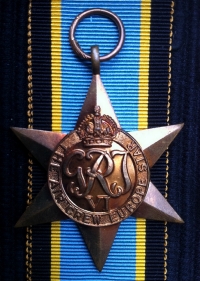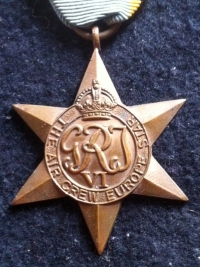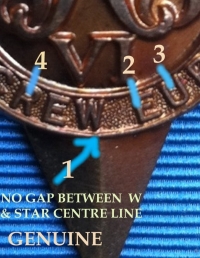COMPARISON PHOTOS OF GENUINE & FAKE
AIRCREW EUROPE STARS
'FOUR EASY STEPS TO TELL RIGHT from WRONG'
( *So now there is no excuse for Internet sellers
to claim they don't know right from wrong !)
The differences between Genuine and Fake Aircrew Europe Stars are easy to spot and will cause no confusion when attempting to tell the 'right' from the 'wrong'. To begin with, when inspecting a 'Mint' and genuine star,(Picture 1) it will still exhibit lots of its original bright mint luster in the same way as does a new 'copper' coin which has not been long from the mint. This fades over time to produce an attactive 'subdued' red-brown patina. The basic surfaces on a genuine star are hard, smooth and glossy, particularly in the field areas around the Royal Cypher. The Fakes (Picture 2) are generally a mid-sand-brown in colour and don't exhibit any of that nice original mint colour. Even genuine stars which have been cleaned and thus lost their original surface sheen, and have toned down with age, unless heavily polished (which is rare with originals) will still look 'sharp' and have a 'crisp' appearance to the strike.
PHOTO DIAGNOSTICS As can be seen from the pictures below there are at least four easy visual checks that can be instantly made to determin if the Aircrew Europe Star you are viewing is genuine or a fake. All these four checks are in the lower central area of the medal and will actually save you getting eye strain by trying to count the microscopic pearls in the crown which is yet another method of telling real from wrong!
(Check No.1) This is the easiest immediate check and it can be made even without an eye glass. I ALWAYS CHECK THIS PLACE FIRST.
On a genuine star (picture left) the right hand lower foot point of the 'W' in CREW accurately meets the vertical centre-line of the lower star point. On the Fake, there is a clear GAP between the centre-line and the W right foot point. The entire W on the fake being shifted well to the left of centre.
(Check No.2) This is also an easy check. On an original star the foot of the 'I' of the VI in the Royal Chypher almost exactly meets the vertical upstroke of the 'E' of EUROPE. on a fake, the right foot of the 'I' sits halfway across the horizontal top bar of the 'E'
(Check No.3) This and the next check are to do with the size and shape of a couple of easy to see letters. On a genuine star the width of the curve in the 'U' of EUROPE is neat and tight. On a fake the 'U' is so wide you could drive a truck through it !
(Check No.4) This also has to do with letter shape. On a Genuine Star the letter 'R' in CREW exhibits a small, tight and accurate 'D' shape to its upper aperture. On a Fake, this top space in the R is long, flat and a lot wider than on the genuine medal.
SUMMARY
Basically the way to tell the right from the wrong is a matter of looking at the general appearance and 'accuracy' of the medal in hand. The lettering, its shape and positional features in relation to other fixed points in the design are the best way to spot a fake. The lettering on fakes is generally always flatter and less accurate than on a genuine medal. It's always a good idea to carry a fake in your wallet to refer to (and a genuine star if you can). Otherwise, please feel free to print out any of the above pictures and keep them handy. Also, as of May 2013, if it's being asked at much less than £250-£275 it's probably a fake.
So there you have it ....No more confusion and hopefully no more losses of your hard earned cash on the auction sites.
REMEMBER ..A FAKE IS WORTH NOTHING !
AND If you see a medal which is clearly a fake being sold on line, or a medal which has a misleading "make your own mind up" or "not sure" type of description, then let us know on the RED "REPORT A FAKE ITEM" link at top right above and we will list it on these pages in an attempt to stop any more collectors being robbed.
THANK YOU
Medals of England



